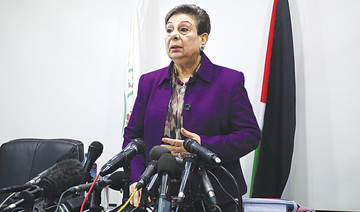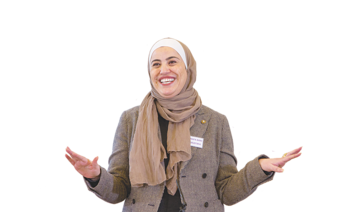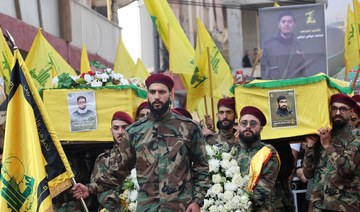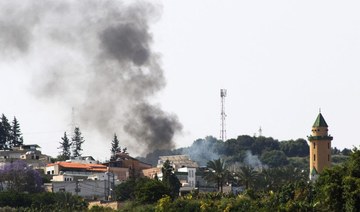GAZA: Amid the poverty and deprivation of the Gaza Strip, Palestinian women struggle to find a taste of normality that is taken for granted in much of the rest of the world.
Nada Rudwan used to work in digital marketing, but as her work slowed — unemployment in Gaza stands at nearly 50 percent — she decided to put her tech skills toward one of her passions: cooking.
“It was difficult to find a job, so I thought of doing something I like and that will make me money at the same time,” said Rudwan, 27, who posts cooking tutorials to social media platforms under the name “Nada Kitchen.”
Rudwan said she earns income from YouTube proceeds and that several companies in Saudi Arabia recently purchased her videos.
“It is an attempt to beat the physical blockade of Gaza by finding a job that just needs some talent, a camera and Internet connection,” she said.
More than 2 million Palestinians — mostly descendants of people who were driven out or fled from territory that is now Israel at its founding in 1948 — are packed into the narrow Gaza Strip, which shares borders with Israel and Egypt.
Israel maintains tight control of Gaza’s land and sea borders, citing security concerns emanating from Hamas, the Islamist group which controls the coastal territory. Egypt also restricts movement in and out of Gaza on its border.
Those restrictions have devastated Gaza’s economy and left many of its women, like Rudwan’s younger sister, struggling to find work after graduating from college.
“It is hard to find a job that will allow you take care of your needs,” said Lama Rudwan, 22, a media and communications graduate who joined her sister’s cooking project after an unsuccessful job search.
Disapproving community
Some young women in Gaza speak of struggles in their personal lives, as well. They say shopping and even getting married is made more difficult by the restrictions of Israel, which has fought three wars with Hamas over the past decade.
Hana Abu El-Roos, 18, said she plans to get married this summer but can’t find items she needs for her wedding in any of Gaza’s shops. “I haven’t picked my wedding dress yet,” said El-Roos, who is also busy preparing for her final high school exams. “I am confused. My sisters are helping me.”
Other Gaza women say community pressures weigh on them as they seek to bypass Gaza’s economic struggles by working jobs which some see as non-traditional.
Sahar Yaghi took up work as a wedding planner soon after dropping out of university to earn income for her family.
Yaghi’s party-planning requires her to stay up late at night. She said she sometimes hears some of her neighbors, who view her work as inappropriate, making comments about her.
“I hate some comments. But I love my job and hope to have my own business,” Yaghi, 28, said, adding she wants to become the “first female party planner” in Gaza.
For those Gaza women who do have work, the constant fear of losing their job heightens their sense of insecurity.
Sara Abu Taqea said she found temporary work in a Gaza hospital after finishing a bachelor’s degree in midwifery, but that many of her colleagues were not so lucky.
“It is a six-month contract, with no guarantee of further employment,” said Abu Taqea, 23, who works in the maternity ward at Gaza’s Al-Ahli hospital.
Abu Taqea said she finds a sense of solace in the Mediterranean Sea, whose waves crash along Gaza’s coast.
“We are lucky to have the sea. The beach is a place for relief, and for meditation, so we can forget about the wars and poverty,” Abu Taqea said.
In Gaza, women walk thin line between hope and despair
In Gaza, women walk thin line between hope and despair

- Other Gaza women say community pressures weigh on them as they seek to bypass Gaza’s economic struggles by working jobs which some see as non-traditional
- Those restrictions have devastated Gaza’s economy and left many of its women struggling to find work after graduating from college
Syria says Israeli strike kills girl, wounds 10 civilians
The Observatory said the Israeli strikes targeted “at least one military site... in the eastern countryside of Homs, causing plumes of smoke to rise“
BEIRUT: Syria’s defense ministry said an Israeli air strike Wednesday killed a girl and wounded 10 civilians on the country’s coast, with a war monitor reporting another raid killed three pro-Hezbollah fighters.
“The Israeli enemy launched an air attack from the direction of Lebanon, targeting a central site and a residential building in Baniyas city in the coastal region, killing a girl and wounding 10 civilians,” a ministry statement said.
The Syrian Observatory for Human Rights war monitor said the girl was killed after an Israeli missile and Syrian air defense missile exploded and then fell on the coast.
“Two explosions resonated... in the coastal city of Baniyas, killing a girl,” said the Britain-based monitor, which put the number of civilians wounded higher at 20.
The Observatory said “the explosions resulted from an Israeli missile and a Syrian air defense missile falling.”
The Observatory also said the Israeli strike on central Syria killed three Syrian fighters working with Lebanon’s Hezbollah group.
“Three Syrian fighters working with the Lebanese Hezbollah group were killed in an Israeli strike targeting a military site... in the eastern countryside of Homs,” said the Observatory.
Earlier on Wednesday, state media had said air defenses intercepted Israeli “targets” over central Syria, and the Observatory reported an Israeli attack on a military site.
“Syrian air defense intercepts enemy targets in the skies of the city of Homs,” the official SANA news agency reported.
The Observatory said the Israeli strikes targeted “at least one military site... in the eastern countryside of Homs, causing plumes of smoke to rise.”
The monitor, which has a network of sources inside Syria, said the area also housed members of Iran-backed groups including Lebanon’s powerful Hezbollah.
On Saturday, an Israeli drone strike in central Syria, near the border with Lebanon, killed two Hezbollah fighters, the Observatory had said.
Israel rarely comments on individual strikes in Syria but has repeatedly said it will not allow its arch-enemy Iran to expand its presence there.
Israel has carried out hundreds of strikes in Syria since the outbreak of the civil war in its northern neighbor, mainly targeting army positions and Iran-backed fighters including from Hezbollah.
The strikes have increased since Israel’s war with Hamas in the Gaza Strip began on October 7, when the Iran-backed Palestinian militant group launched an unprecedented attack against Israel.
Syria’s war has killed more than half a million people and displaced millions more since it erupted in 2011 after Damascus cracked down on anti-government protests.
‘All Eyes on Rafah’ image garners millions of shares in latest social media solidarity campaign

- Image depicts tents in a camp arranged to spell out “All Eyes on Rafah”
- By Wednesday morning, post surpassed 40 million shares on Instagram
LONDON: The image “All Eyes on Rafah” has garnered millions of shares in the latest social media solidarity campaign, drawing widespread attention to the ongoing conflict between Israel and Gaza.
The post renewed advocacy efforts following a deadly Israeli airstrike on the city in southern Gaza.
According to Forbes, the slogan appears to have originated from a comment by Rik Peeperkorn, director of the World Health Organization’s Office of the Occupied Palestinian Territories.
In February, Peeperkorn used the phrase to shift attention toward Rafah after Israeli Prime Minister Benjamin Netanyahu ordered an evacuation plan for the city ahead of planned attacks targeting what Netanyahu claims are the last remaining strongholds of the militant group Hamas.
By Wednesday morning, the post had surpassed 40 million shares on Instagram, with the hashtag #AllEyesonRafah trending across social media platforms.
The image, believed to be one of the first examples of AI-generated viral activist artwork, depicts tents in a camp arranged to spell out “All Eyes on Rafah.”
The phrase is intended to highlight the plight of Rafah, where local authorities reported the loss of at least 45 civilian lives following an Israeli airstrike on Sunday, which Netanyahu described on Monday as a “tragic mistake.”
Israel has faced international scrutiny for the attack, which is part of a broader offensive by the Israeli army in and around Rafah.
The decision has been widely condemned by world leaders who have urged Israel to halt its invasion in an area where about 1.4 million displaced Palestinians from elsewhere in the Gaza Strip had sought shelter.
Last Friday, the International Court of Justice ordered an immediate halt to the offensive, a position rejected by Israel.
In an opinion piece in The Jewish Chronicle on Wednesday, journalist Josh Kaplan described the post as “another vapid, lazy way to say ‘I care,’” arguing that the slogan “is one in the long canon of feel good posts that achieve very little but make the sharer feel, even just for a second, like they’re doing something to help.”
Kaplan wrote: “I understand that there is outrage at the way Israel is conducting its war. The images coming out of Gaza often feel indefensible. But what does sharing an AI image that looks nothing like Gaza actually do?”
He added: “To learn about the conflict and to formulate an opinion that maintains dignity for all sides is something that cannot be accomplished by sharing an Instagram post. All it does is make Israelis, who will have to be involved in any future peace process, feel, yet again, that the world doesn’t care about their suffering.”
Yemen’s Houthis say they downed US MQ-9 drone in Yemen’s Maareb

- Houthis’s spokesman Yahya Sarea said that this drone “is the sixth UAV that has been shot down so far“
CAIRO: Yemen’s Iran-aligned Houthis said they downed a US MQ-9 drone in Yemen’s southeastern province of Maareb, the group’s military spokesman said in a televised speech on Wednesday.
Houthis’s spokesman Yahya Sarea said that this drone “is the sixth UAV that has been shot down so far.”
On May 21, Houthis shot down another drone over Al-Bayda province in Southern Yemen.
The group, which controls Yemen’s capital and most populous areas of the Arabian Peninsula state, has attacked international shipping in the Red Sea since November in solidarity with the Palestinians in the war between Israel and Hamas militants, drawing US and British retaliatory strikes since February.
Israel says it seizes key Gaza-Egypt corridor

- “Israel is using these allegations to justify continuing the operation on the Palestinian city of Rafah and prolonging the war for political purposes,” Egyptian source said
- Israel’s National Security Adviser Tzachi Hanegbi said, however, that the war could go on until the year’s end
GAZA: The Israeli army said it took control on Wednesday of a vital Gaza-Egypt corridor suspected of aiding weapons smuggling as it intensified its offensive against Hamas in the border city of Rafah.
The UN Security Council was set to meet for a second day of emergency talks after a strike at the weekend ignited a fire that Gaza officials said killed 45 people and injured about 250.
United Nations Secretary-General Antonio Guterres was among the many leaders to voice revulsion at the bloodshed, demanding that “this horror must stop.”
Israel’s National Security Adviser Tzachi Hanegbi said, however, that the war could go on until the year’s end.
“We may have another seven months of fighting to consolidate our success and achieve what we have defined as the destruction of Hamas’s power and military capabilities,” Hanegbi said.
An Israeli military official later told reporters the army had taken “operational control” of the strategic, 14-kilometer (8.5-mile) Philadelphi corridor along the Gaza-Egypt border.
The corridor had served as a buffer between Gaza and Egypt, but since Israel withdrew from Gaza in 2005, there were fears it was being used to channel weapons to armed groups in the Palestinian territory.
Its seizure comes weeks after Israeli forces took the Palestinian side of the Rafah border crossing with Egypt, which alleged Wednesday Israel was using claims of cross-border tunnels as cover for its Rafah offensive.
“Israel is using these allegations to justify continuing the operation on the Palestinian city of Rafah and prolonging the war for political purposes,” a high-level Egyptian source was quoted as saying by state-linked Al-Qahera News.
In besieged Rafah, witnesses reported escalated fighting with helicopters intensifying attacks, supported by artillery and smoke grenades.
Hamas’s military wing said it was firing rockets at Israeli troops.
AFPTV footage showed Palestinians with bloodied midriffs and bandaged limbs after being wounded in strikes near Khan Yunis, close to Rafah, being taken to the European Hospital on makeshift gurneys.
“The rockets fell directly on us. I was hurled three meters (yards)... I don’t know how I managed to get up on my feet,” said one who did not give his name.
Gaza’s civil defense said three bodies were recovered from a Khan Yunis house after it was shelled.
The United States has been among the countries urging Israel to refrain from a full-scale offensive into Rafah, the last Gaza city to see ground fighting, because of the risk to civilians.
However, the White House said Tuesday that so far it had not seen Israel cross President Joe Biden’s “red lines,” with National Security Council spokesman John Kirby saying: “We have not seen them smash into Rafah.”
On Wednesday, US Secretary of State Antony Blinken called on Israel to quickly devise a post-war strategy for Gaza, stressing: “In the absence of a plan for the day after, there won’t be a day after.”
A steady stream of civilians has been fleeing Rafah, the new hotspot in the gruelling war, many carrying belongings on their shoulders, in cars or on donkey-drawn carts.
Before the Rafah offensive began on May 7, the United Nations had warned that up to 1.4 million people were sheltering there. Since then, one million have fled the area, the UN agency for Palestinian refugees (UNRWA) has said.
Israeli Prime Minister Benjamin Netanyahu called Sunday’s strike and ensuing fire a “tragic accident.” The army said it had targeted a Hamas compound and killed two senior members of the group.
Israel’s military said it was investigating the strike, and its spokesman Daniel Hagari said on Tuesday that “our munition alone could not have ignited a fire of this size.”
Gaza civil defense agency official Mohammad Al-Mughayyir said 21 more people were killed in a similar strike Tuesday “targeting the tents of displaced people” in western Rafah.
The army denied this, saying it “did not strike in the humanitarian area in Al-Mawasi,” an area it had designated for displaced people from Rafah to shelter.
New fighting also hit other areas of the besieged Palestinian territory of 2.4 million people.
In the north, Israeli military vehicles unleashed intense gunfire east of Gaza City, an AFP reporter said, and residents reported strikes on Jabalia.
The Gaza war was sparked by Hamas’s October 7 attack on southern Israel, which resulted in the deaths of 1,189 people, mostly civilians, according to an AFP tally based on Israeli official figures.
Militants also took 252 hostages, 121 of whom remain in Gaza, including 37 the army says are dead.
Israel’s retaliatory offensive has killed at least 36,171 people in Gaza, mostly civilians, according to the Hamas-run territory’s health ministry.
Nearly eight months into the deadliest Gaza war, Israel has faced ever louder opposition and cases before two Netherlands-based international courts.
At the UN Security Council, Algeria has presented a draft resolution that “demands an immediate ceasefire respected by all parties” and the release of all hostages.
Algeria’s UN ambassador Amar Bendjama has not specified when he hopes to put the draft to a vote.
Chinese ambassador Fu Cong expressed hope for a vote this week as President Xi Jinping told Egyptian President Abdel Fattah El-Sisi in Beijing he was “deeply pained” by the situation in Gaza.
French UN ambassador Nicolas de Riviere said “it’s high time for this council to take action. This is a matter of life and death. This is a matter of emergency.”
US ambassador Linda Thomas-Greenfield, when asked about the draft resolution, said: “We’re waiting to see it and then we’ll react to it.”
Brazil, whose ties with Israel have soured over the war, on Wednesday recalled its ambassador, further raising tensions between the two.
Meanwhile, the World Central Kitchen nonprofit organization said it was stopping its operations in Rafah because of “ongoing attacks” in the southern city.
Lebanese army under attack from Israeli machine guns

- UNIFIL commander: ‘Death and destruction are heartbreaking’
- Hezbollah said they had attacked “the newly installed espionage equipment at the Al-Raheb site, hitting it directly and destroying it”
BEIRUT: A Lebanese army site on the outskirts of the border town of Alma Al-Shaab came under machine gun fire from the Israeli army on Wednesday. Nobody was injured in the incident.
Israeli artillery also targeted the outskirts of Mays Al-Jabal, Wazzani, Jebbayn, Chihine and Kfarkela.
A statement from Hezbollah said it in turn had attacked “the newly installed espionage equipment at the Al-Raheb site, hitting it directly and destroying it.”
Israeli army spokesman Avichay Adraee said air defenses had intercepted a “suspicious aerial object” in the Ras Naqoura area without activating any sirens.
“Warplanes attacked a military building containing Hezbollah members in the Naqoura area. The planes also attacked Hezbollah buildings in Ramyah and Al-Tiri in southern Lebanon,” he said. A raid on the town of Naqoura caused minor injuries to several citizens.
The head of the United Nations Interim Force in southern Lebanon, Gen. Aroldo Lazaro, urged all parties to cease their fire, recommit to Resolution 1701, and begin the work toward a political and diplomatic solution, which he said was the only way to resolve the situation.
The security situation in the area meant UNIFIL did not hold any celebrations to mark the International Day of United Nations Peacekeepers on Wednesday.
In a statement, Gen. Lazaro said: “The death and destruction we have seen on both sides of the Blue Line is heartbreaking. Too many lives have been lost and disrupted. Thousands of people remain displaced and have lost their homes and their livelihoods. As peacekeepers, we recommit each day to our work to restore stability.”
Peacekeepers from 49 nations are currently in the south and report regularly to the Security Council.
Yesterday, Jean-Yves Le Drian, the French president’s special envoy to Lebanon, met with the head of Hezbollah’s Loyalty to Resistance parliamentary bloc, MP Mohammad Raad, at its office in Beirut.
He arrived on Tuesday evening on his sixth mission to discuss developments in the country with Lebanese officials.
Le Drian met with several officials, including caretaker Prime Minister Najib Mikati and Speaker of the Parliament Nabih Berri, along with other heads of opposition Christian parties and the National Moderation bloc made up of mostly Sunni deputies.
According to the leaked information, the French official insisted on the need for consultation among Lebanese powers to name a president.
Le Drian warned: “Lebanon’s political feature will be gone if the crisis remains and if the presidential vacuum persists. Lebanon will save nothing but its geographical feature.”
Berri assured Le Drian that he would “be adhering to calling for unconditional consultations focused on the presidential election and moving to the parliament to conduct successive voting rounds with a list of candidates until a new president of the republic is elected.”






















